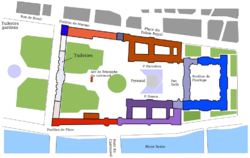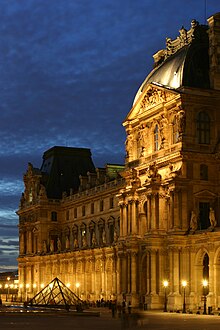Louvre Palace
- For the museum see Louvre Museum.
The palais du Louvre in Paris, on the Right Bank of the Seine is a former royal palace, situated between the Tuileries Gardens and the church of Saint-Germain l'Auxerrois. Its origins date back almost a thousand years and its present structure has evolved in stages since the sixteenth century.
The Louvre, which gets its name from a Frankish word leovar or leower, signifying a fortified place, according to the French historian Henri Sauval (1623-1676), was the actual seat of power in France until Louis XIV moved to Versailles in 1682, bringing the government perforce with him; the Louvre remained the formal seat of government to the end of the Ancien Régime.

Medieval Louvre
The first royal "Castle of the Louvre"—it was first mentioned under this name in a charter of 1198—was founded on the edge of medieval Paris by King Philip Augustus as a fortified royal palace to defend the western flank of the city on the Rive Droite (right bank). The structure consisted of a rectangular enclosure wall with towers at the corners and the middle of the sides, as well as two strong gates. In the centre of the courtyard of the castle was a tall keep, isolated by its own moat. Charles V remodelled the structure to provide some suitably splendid apartments. Later kings such as François I and Henri II systematically demolished the original castle to build a Renaissance palace. The remains of both the curtains and the keep can be seen in the Medieval Louvre gallery.
The Renaissance

The earliest above ground part of the Palais du Louvre was begun in 1535. The architect Pierre Lescot introduced to Paris the new design vocabulary of the Renaissance, which had been developed in the châteaux of the Loire Valley. His new wing for the old castle defined its status, as the first among the royal palaces. Jacques Androuet du Cerceau also worked on the Louvre.
During his reign (1589-1610), Henri IV added the Grande Galerie. More than a quarter of a mile long and one hundred feet wide, this huge addition was built along the bank of the Seine; at the time of its completion it was the longest edifice of its kind in the world. Henri IV, a promoter of the arts, invited hundreds of artists and craftsmen to live and work on the building's lower floors. This tradition continued for another 200 years until Napoleon III ended it.

Louis XIII (1610-1643) completed the wing now called the Denon Wing, which had been started by Catherine de' Medici in 1560. Today it has been renovated, as a part of the Grand Louvre Renovation Programme.
The Richelieu Wing was also built by Louis XIII, the building first being opened to the public as a museum on November 8, 1793 during the French Revolution.
The Louvre under the Sun King
Commissioned by Louis XIV, architect Claude Perrault's eastern wing (1665-1680), crowned by an uncompromising Italian balustrade along its distinctly non-French flat roof, was a ground-breaking departure in French architecture. His severe design was chosen over a design provided by the great Bernini, who came to Paris for the purpose. Perrault had translated the Roman architect Vitruvius into French. Now Perrault's rhythmical paired columns form a shadowed colonnade with a central pedimented triumphal arch entrance raised on a high, rather defensive basement, in a restrained classicizing baroque manner that has provided models for grand edifices in Europe and America for centuries. The Metropolitan Museum in New York, for one example, reflects Perrault's Louvre design.
Later works
The Louvre was still being added to by Napoleon III. The new wing of 1852-1857, by architects Visconti and Hector Lefuel, represents the Second Empire's version of Neo-baroque, full of detail and laden with sculpture. Work continued until 1876.
